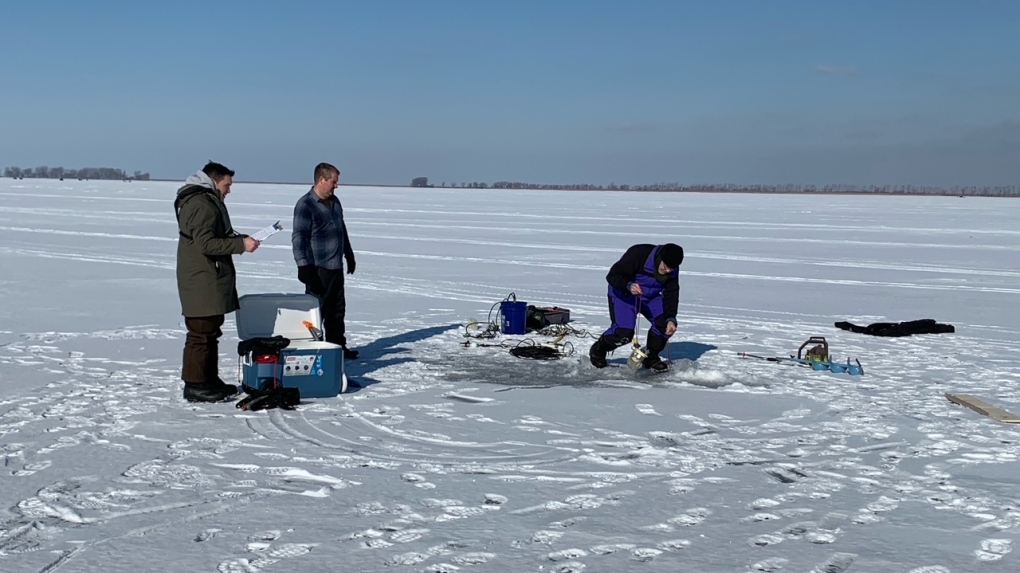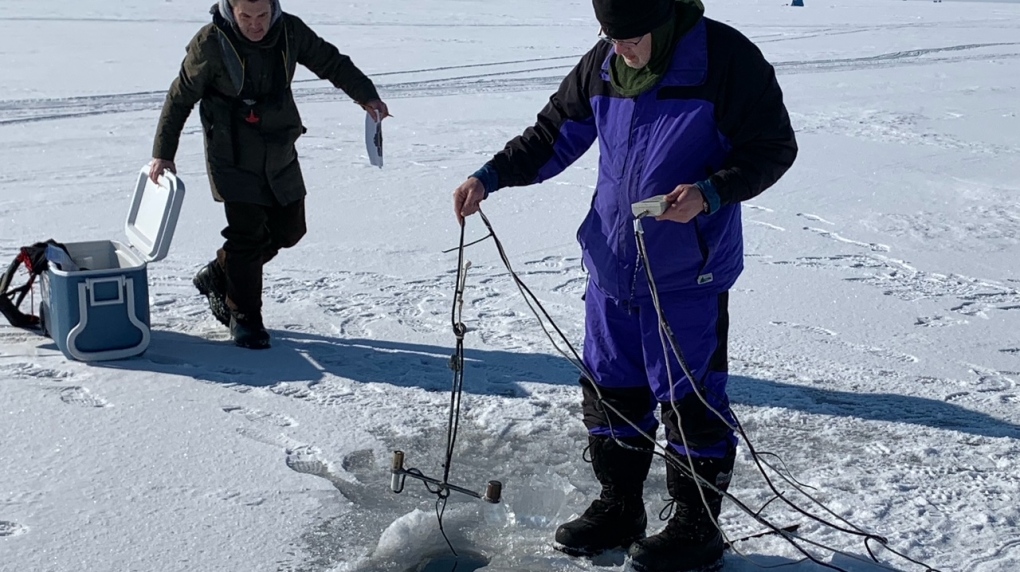Researchers to study the winter mysteries of the Great Lakes ecosystem
Dozens of researchers from across Canada and the U.S. are embarking on a first-of-its-kind study in the Great Lakes region this week to uncover the mysteries of what lies beneath the surface during the winter months.
The event dubbed the “Winter Grab” involves bi-national scientists from several institutions including the University of Windsor to fill the knowledge gaps of what takes place in the largest source of fresh water in the world year-round.
“It’s the black box of the Great Lakes ecosystem,” says executive director of the Great Lakes Institute for Environmental Research (GLIER) Mike McKay. “What’s happening under the ice?”
McKay was joined by environment professor Ken Drouillard, and GLIER field technician Aaron Newhook on Tuesday to collect water, ice and light penetration samples from Mitchell’s Bay on Lake St. Clair.
 Researchers collecting samples for a study to uncover the mysteries of what lies beneath the surface during the winter on Lake St. Clair in Mitchell’s Bay, Ont. on Tuesday, Feb. 15, 2022. (Chris Campbell/CTV Windsor)
Researchers collecting samples for a study to uncover the mysteries of what lies beneath the surface during the winter on Lake St. Clair in Mitchell’s Bay, Ont. on Tuesday, Feb. 15, 2022. (Chris Campbell/CTV Windsor)
Nets were also dropped to collect plankton.
Samples from all five Great Lakes as well as Lake St. Clair are being gathered in the coordinated campaign that typically takes place during warmer, open water seasons.
“We’ve had a number of one-off efforts to do some winter science on the lakes, but to see a coordinated binational effort like this is really exciting,” McKay says.
McKay says collecting Great Lake samples in the winter doesn’t typically happen for various logistical reasons, including a lack of safe platforms and the winter elements.
“I think there was a notion that maybe not much is happening, that things go dormant. It’s cold, it’s often dark, especially snow-covered ice,” he says. “As long as there’s light that can penetrate through the ice into the water, there’s going to be life.”
 Researchers collecting samples for a study to uncover the mysteries of what lies beneath the surface during the winter on Lake St. Clair in Mitchell’s Bay, Ont. on Tuesday, Feb. 15, 2022. (Chris Campbell/CTV Windsor)
Researchers collecting samples for a study to uncover the mysteries of what lies beneath the surface during the winter on Lake St. Clair in Mitchell’s Bay, Ont. on Tuesday, Feb. 15, 2022. (Chris Campbell/CTV Windsor)
McKay explains to better predict the effect of declining ice cover, there needs to be a comprehensive understanding of the winter season.
“Colleagues who were sampling Green Bay yesterday in Wisconsin, they came up with green water,” he says. “We typically think of these blue-green algae being a summertime phenomenon, but increasingly we’re starting to see some forms of them actually persist in the winter.”
McKay tells CTV News ice on the Great Lakes is important, noting there’s been a 71 per cent decrease in ice coverage on the Great Lakes over the last 50 years.
McKay believes the Winter Grab is a chance to highlight the importance of the winter ecosystem and the importance of ice.
“We’re starting to see some interest from federal and provincial agencies to start winter monitoring programs as part of their agency monitoring so really exciting on that front to see the interest so we’re hoping to parlay that interest and build on it with this event this week,” he says.
 Researchers collecting samples for a study to uncover the mysteries of what lies beneath the surface during the winter on Lake St. Clair in Mitchell’s Bay, Ont. on Tuesday, Feb. 15, 2022. (Chris Campbell/CTV Windsor)
Researchers collecting samples for a study to uncover the mysteries of what lies beneath the surface during the winter on Lake St. Clair in Mitchell’s Bay, Ont. on Tuesday, Feb. 15, 2022. (Chris Campbell/CTV Windsor)
CTVNews.ca Top Stories

'Anything to win': Trudeau says as Poilievre defends meeting protesters
Prime Minister Justin Trudeau is accusing Conservative Leader Pierre Poilievre of welcoming 'the support of conspiracy theorists and extremists,' after the Conservative leader was photographed meeting with protesters, which his office has defended.
'My stomach dropped': Winnipeg man speaks out after being criminally harassed following single online date
A Winnipeg man said a single date gone wrong led to years of criminal harassment, false arrests, stress and depression.
Ukraine uses long-range missiles secretly provided by U.S. to hit Russian-held areas, officials say
Ukraine for the first time has begun using long-range ballistic missiles provided secretly by the United States, bombing a Russian military airfield in Crimea last week and Russian forces in another occupied area overnight, American officials said Wednesday.
'One of the single most terrifying things ever': Ontario couple among passengers on sinking tour boat in Dominican Republic
A Toronto couple are speaking out about their 'extremely dangerous' experience on board a sinking tour boat in the Dominican Republic last week.
All Alberta wildfires to date in 2024 believed to be human-caused: province
There are 63 wildfires burning in Alberta's forest protection area as of Wednesday morning and seven mutual aid fires, including one in the Municipal District of Peace.
7 surveillance videos linked to extortions of South Asian home builders in Edmonton released
The Edmonton Police Service has released a number of surveillance videos related to a series of extortion cases in the city now dubbed 'Project Gaslight.'
Suspects waving weapons, smashing glass in Toronto jewelry store robbery caught on video
Arrests have been made after five men were captured on video rampaging through a jewelry store in Toronto, waving weapons and smashing glass display cases.
Bank of Canada officials split on when to start cutting interest rates
Members of the Bank of Canada's governing council were split on how long the central bank should wait before it starts cutting interest rates when they met earlier this month.
New evidence challenges the Pentagon's account of a horrific attack as the U.S. withdrew from Afghanistan: CNN exclusive
New video evidence uncovered by CNN significantly undermines two Pentagon investigations into an ISIS-K suicide attack outside Kabul airport, during the American withdrawal from Afghanistan in 2021.





























